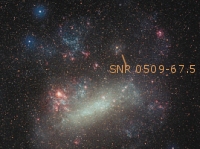Characterisation of SNR 0509-67.5
20 March 2008
Optical observations by Rest et al. of light echoes from the supernova (SN) explosion that created the supernova remnant SNR 0509-67.5 have allowed for the determination of the SN's subtype and age, some 400 years after the event. This conclusive determination of SN subtype so long after the explosion of the parent star is confirmed by results from analyses of X-ray observations by Badenes et al. that use Chandra and XMM-Newton spectra of the SNR's shocked ejecta material.With the determination of the type and more importantly the subtype of SN responsible for the SNR the two teams have successfully determined the kinetic energy of the SN explosion.
Optical light echo spectrum
 |
|
Location of SNR 0509-67.5 in the LMC. Credit: Eckhard Slawik |
Following up on these observations, spectra were obtained of the light echoes using the GMOS spectrograph on the Gemini-South telescope (Cerro Pachón, central Chile).
In an article accepted for publication in the Astrophysical Journal, Rest et al. use a light echo spectrum located at an angular separation of 0.34° from the SNR 0509-67.5 to determine the age and type of the SN responsible for this remnant.
The observed light echo spectrum, covering the wavelength range ~4500-8500 Å, is the result of scattering of the supernova light off of dust sheets. These dust sheets are large enough to have a significant light travel time compared to the original supernova explosion. The light echo spectrum therefore is a time-integration of the supernova flux attenuated by the scattering dust in the sheet.
To determine the type and subtype of SN responsible for the light echo, Rest et al. created a library of 34 spectra from different types of SNe. These were time-integrated from -15 days to +85 days around the time of peak emission in the B band and next multiplied by the scattering function of the dust and corrected for extinction toward the LMC.
As a final step both the observed light echo spectrum and the 34 library spectra were flattened by dividing the spectrum by a pseudo continuum, leaving only the main spectral features.
By correlating the spectral features of the observed light echo spectrum with those of the library spectra Rest et al. conclude that a supernova of type Ia-91T was responsible for creating SNR 0509-67.5. From the range of SN (sub)types in the library (Ia-norm, Ia-91T, Ia-91bg, Ib-norm, Ib-pec, Ic-norm, Ic-broad) this in fact was found to be the only (sub)type of SN that correlated well with the light echo data.
From the apparent motion of the light echo, the age of the SNR is found to be about 400 years, with a margin of ± 120 years. This age is confirmed by Carlos Badenes et al. who employ another method based on X-ray spectral data. This method also is able to tighten the age margin to a few decades around the nominal 400 year age.
X-ray spectrum of the supernova remnant
In an upcoming article in the Astrophysical Journal, Carlos Badenes et al. present their results from the method that uses X-ray observations of the supernova remnant itself, obtained by XMM-Newton and Chandra, to determine the age and the kinetic energy of the SN explosion that produced the remnant.
Type Ia SNe are best modelled by delayed detonation (DDT) models, in which the burning front from the core of a white dwarf initially travels subsonically outward until a certain density is reached after which the front makes a transition to the supersonic regime resulting in the explosive end of the white dwarf.
For a range of DDT SN Ia models with kinetic energies between 0.9-1.4 × 1051 erg (corresponding to the range of dim to bright SNe Ia) Badenes et al. generated the synthetic spectrum of the resultant SNR. Important parameters for generating the spectra were the density of the ambient medium (varied between 5×10-26 - 5×10-24 g cm-3) in which the ejecta material is propagating and the age of the SN.
The X-ray observations of the spectral features in the SNR 0509-67.5, combined with constraints on the SNR's dynamics (angular size, shock velocity) lead the authors to conclude that it requires the most energetic of the DDT models to create a SNR with the X-ray signatures as those observed by XMM-Newton and Chandra.
They find that the 400 year old SN responsible for SNR 0509-37.5 was of the energetic (sub)type Ia-91T with a kinetic energy of 1.4 × 1051 erg.
The combined results from Rest et al. and Badenes et al. prove two independent and powerful methods that are capable of obtaining detailed information of a supernova explosion's characteristics long after its occurrence, by extracting the information from its relic light echoes and its radiating remnant gases.
Related publications
Rest, A. et al. (2008), "Spectral Identification of an Ancient Supernova using Light Echoes in the LMC", ApJ, in press
Badenes, C. et al. (2008), "The Persistence of Memory, or How the X-Ray Spectrum of SNR 0509-67.5 Reveals the Brightness of its Parent Type Ia Supernova", ApJ, in press
Rest, A. et al., "Light echoes from ancient supernovae in the Large Magellanic Cloud", Nature, 438, 1132-1134, 22 Dec 2005
